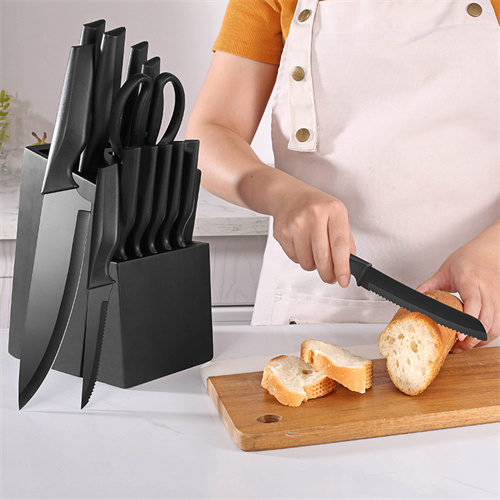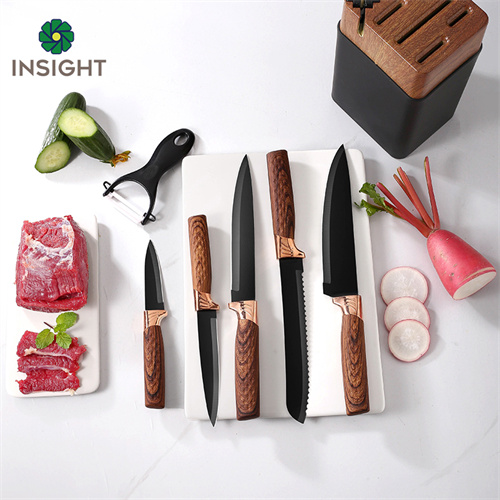

Views: 700 Author: sales@insightknife.com.cn Publish Time: 2025-01-20 Origin: Site








Content Menu
● Common Mistakes That Can Ruin a Knife
>> Neglecting to Clean the Whetstone
>> Not Using Enough Lubrication
>> Uneven Edge
● Maintaining Your Knife After Sharpening
● Frequently Asked Questions regarding Knife Sharpener
>> 1. What is the best angle to sharpen a knife on a whetstone?
>> 2. How often should I sharpen my knives with a whetstone?
>> 3. Can I use a whetstone on all types of knives?
>> 4. What should I do if my knife has a chip in the blade?
>> 5. How do I know when my knife is sharp enough?
Sharpening knives is an essential skill for anyone who cooks, whether professionally or at home. A whetstone is one of the most effective tools for achieving a sharp edge on a knife. However, improper use of a whetstone can lead to damaging the knife rather than enhancing its performance. This article explores the intricacies of knife sharpening with a whetstone, the potential pitfalls, and how to avoid ruining your knife.
A whetstone, also known as a sharpening stone, is a tool used to grind and hone the edges of steel tools and implements. Whetstones come in various materials, including natural stones and synthetic composites. Natural whetstones, such as Arkansas stones, are prized for their unique properties and ability to produce a fine edge. Synthetic stones, on the other hand, are often more consistent in grit and performance, making them popular among both amateur and professional chefs. They are categorized by their grit levels, which determine how coarse or fine the stone is. Coarse stones are used for repairing damaged edges, while finer stones are used for honing and polishing. Understanding the different types of whetstones and their applications is crucial for achieving the desired sharpness and maintaining the longevity of your knives.
Whetstones can be classified into several types based on their grit:
Coarse Grit (200-600): Ideal for reshaping and repairing dull or damaged blades. These stones are particularly useful for knives that have been heavily used or have chips in the edge. They remove material quickly, allowing for significant reshaping of the blade.
Medium Grit (800-2000): Suitable for general sharpening and refining the edge. This range is perfect for regular maintenance of kitchen knives, providing a balance between removing material and polishing the edge.
Fine Grit (3000-8000): Used for polishing and achieving a razor-sharp finish. Fine grit stones are essential for professional chefs who require precision and sharpness in their knives, as they help to create a smooth, polished edge that enhances cutting performance.
Understanding the right type of whetstone for your knife is crucial for effective sharpening. Each knife may require a different approach based on its intended use and the material from which it is made.

Before using a whetstone, it is essential to prepare it properly. Most whetstones require soaking in water for about 10 to 15 minutes before use. This soaking helps to keep the stone lubricated during sharpening, preventing metal shavings from clogging the surface and allowing for a smoother sharpening process. Some whetstones, particularly oil stones, require oil instead of water, which serves a similar purpose. Proper preparation not only enhances the sharpening experience but also prolongs the life of the whetstone itself.
The technique used while sharpening is critical. The knife should be held at a consistent angle, typically between 15 to 20 degrees, depending on the knife type. For example, Japanese knives often have a sharper angle compared to Western-style knives. The sharpening motion should be smooth and controlled, moving the blade across the stone in a sweeping motion. It is important to apply even pressure and to lift the knife at the end of each stroke to avoid creating a burr, which can damage the edge. Practicing this technique can take time, but it is essential for achieving a sharp and durable edge.
One of the most common mistakes when sharpening a knife is using the wrong angle. If the angle is too steep, it can remove too much material from the blade, leading to a weakened edge. Conversely, if the angle is too shallow, the knife may not sharpen effectively, resulting in a dull blade. Finding the right angle for each specific knife is crucial, as it directly impacts the knife's performance and longevity.
Over-sharpening occurs when excessive pressure is applied or when the knife is sharpened too frequently. This can lead to the thinning of the blade, which compromises its structural integrity. It is essential to sharpen only as needed and to monitor the blade's thickness during the process. Regular maintenance, such as honing, can often prevent the need for frequent sharpening, thus preserving the knife's edge and overall quality.
Failing to clean the whetstone after use can lead to the accumulation of metal particles and debris, which can scratch the knife during subsequent sharpenings. Regularly cleaning the stone with water and a soft brush will help maintain its effectiveness and prolong its lifespan. A clean whetstone ensures that the sharpening process is efficient and that the knife receives an even and consistent edge.
Lubrication is vital when using a whetstone. Insufficient lubrication can cause the stone to become clogged with metal particles, leading to a rough sharpening surface. Always ensure that the stone is adequately lubricated with water or oil, depending on the type of whetstone being used. Proper lubrication not only enhances the sharpening process but also protects the knife from unnecessary wear and tear.
If a knife has visible chips or cracks in the blade, it may be a sign that it has been ruined. These imperfections can occur from improper sharpening techniques or using a whetstone that is too coarse for the blade. Visible damage not only affects the knife's performance but can also pose safety risks during use. Regular inspections of the blade can help identify issues before they become more severe.
If a knife remains dull after sharpening, it may indicate that the edge has been damaged. This can happen if the knife was sharpened at the wrong angle or if too much material was removed during the process. A dull knife can be frustrating to use and can lead to accidents in the kitchen, as more force is often required to cut through food.
An uneven edge can result from inconsistent sharpening techniques. If one side of the blade is sharper than the other, it can lead to poor cutting performance and may require professional repair. Achieving a consistent edge is essential for the knife's effectiveness and can significantly impact the quality of food preparation.
After sharpening, it is essential to maintain the knife's edge through regular honing. Honing involves using a honing rod to realign the edge of the blade, which helps to keep it sharp between sharpenings. This process should be done frequently, especially for knives used daily. Regular honing can extend the time between sharpenings, preserving the knife's edge and reducing wear on the blade.
Storing knives properly is crucial for maintaining their sharpness. Knives should be kept in a knife block, magnetic strip, or sheaths to protect the blades from damage. Avoid storing knives loose in a drawer, as this can lead to nicks and dulling of the edge. Proper storage not only protects the knife but also ensures safety in the kitchen, preventing accidental cuts.

After each use, knives should be cleaned and dried immediately. Avoid placing knives in the dishwasher, as the heat and moisture can damage the blade and handle. Instead, wash them by hand with mild soap and water, then dry thoroughly to prevent rust and corrosion. Proper cleaning and drying techniques are essential for maintaining the knife's appearance and functionality over time.
Using a whetstone to sharpen knives can be a rewarding skill that enhances your culinary experience. However, it is essential to approach the process with care and knowledge. By understanding the types of whetstones, mastering the sharpening technique, and avoiding common mistakes, you can maintain your knives in excellent condition. Remember that proper maintenance and care are just as important as the sharpening process itself. With the right approach, you can enjoy sharp, effective knives for years to come, elevating your cooking and food preparation to new heights.
The best angle to sharpen a knife on a whetstone typically ranges from 15 to 20 degrees. Japanese knives often require a sharper angle of around 15 degrees, while Western-style knives are usually sharpened at 20 degrees. Maintaining a consistent angle is crucial for achieving a sharp and durable edge.
The frequency of sharpening depends on how often you use your knives. For home cooks who use their knives regularly, sharpening every few months is generally sufficient. Professional chefs may need to sharpen their knives more frequently, sometimes weekly or even daily, depending on their usage.
While whetstones can be used on most types of knives, it is essential to consider the blade material and design. High-carbon steel and stainless steel knives respond well to whetstone sharpening. However, ceramic knives should not be sharpened on whetstones, as they require specialized tools due to their brittleness.
If your knife has a chip in the blade, start with a coarse grit whetstone (200-600 grit) to reshape the edge and remove the chip. Once the chip is gone, you can progress to medium and fine grit stones to refine and polish the edge. Be patient, as this process may take some time depending on the severity of the chip.
You can test the sharpness of your knife by performing a simple paper test. Hold a piece of paper vertically and try to slice through it with the knife. If the knife cuts through the paper cleanly and effortlessly, it is sharp enough. Additionally, you can test the knife on a tomato or other soft fruit; a sharp knife should easily penetrate the skin without excessive pressure.